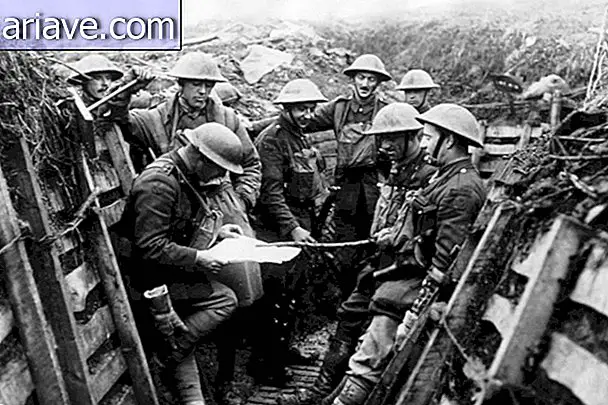When trying to learn more about father, man unveils famous crime
Warning: The images contained in this article can be very shocking to sensitive people.
Many people do not have a good relationship with their parents and can go through life without knowing the truth about them.
After his father's death in 1991, retired police officer Steve Hodel tried to find out more about him. George Hodel was a talented young man who, at the age of 9, was already considered a piano prodigy and, with IQ one point higher than Albert Einstein's, a genius. So much so that at 14 he would be accepted into a college. But genius can take its toll: unable to fit in or act socially, the young man has become introspective and surrendered to drugs.
At age 19, George lied his age to become a police reporter. In his work, he wrote the most lurid accounts of crime scenes in the city alleys. Violence was his greatest inspiration.

Subsequently, George became a well-known physician. Running his own clinic for treating venereal diseases, he learned the secrets of Hollywood studio and celebrity moguls.
The approach to important and famous people made the doctor have big parties, alcohol and drugs, in which the top Los Angeles could feel at ease.
Steve's greatest memory of his father was that of a rigid man who didn't show much emotion but at the same time knew how to have the charisma and charm needed to inspire admiration. In a search for his home, the former police officer found a photograph taken by his father. In it, a woman seems posing naked.

Looking over the record, Steve recognized the face in the picture and immediately remembered Elizabeth Short, a young woman who had been murdered for over 40 years. The reality is that Steve was still a child when the crime happened, but its relevance made it one of the most famous unsolved cases in the United States.
The Black Dahlia Case
Los Angeles, January 15, 1947. A woman's body is found in a wasteland on Nortan Avenue. The scene is shocking: the corpse is cut perfectly in half. His face is cut from ear to ear, forming a macabre smile. The blood had been drained and the body was carefully arranged. The upper torso was 15 cm away from the legs. The arms were raised above the head, bent at a 90 degree angle. She was placed a short distance from the sidewalk so that her body could be seen.


Cops and onlookers stared incredulously at the scene. Investigators would soon identify the girl as 22-year-old Elizabeth Short, an aspiring Hollywood actress. The young woman had fair skin, blue eyes, and curly brown hair. He was dressed in black and wore a Black Dahlia tied to his hair as he strolled down Hollywood Boulevard seductively. These features would result in the nickname “Black Dahlia, ” given by some reporters who covered the murder at the time.

The autopsy revealed careful and professional work: the body had been cut with surgical precision without any internal organs being affected.
Still with no concrete clues about the killer, police began to receive intriguing messages: the alleged criminal sent the victim's purse and enigmatic postcards. Over the next few months, newspapers received various messages from the criminal provoking the press about his identity. Forensic psychiatrists involved in the case have observed a pattern in this kind of unsolved crime: The individual is desperate for recognition, so he has to communicate with the public to receive credit for what he has done.

The mysterious quartering turned the dreamed young woman into a celebrity. Books and movies were inspired by the case, causing Elizabeth to gain a legion of fans in search of more details about the crime.
This fact stirred Hollywood life so much that even legendary film director Orson Welles was investigated. Despite the unrest over the crime, Los Angeles police failed to unravel the murder.

A new investigation
After finding Elizabeth Short's picture among his father's belongings, Steve decided to study the case. For him, the nature of Elizabeth Short's death reveals much about the kind of person who can commit such a crime. It was a terrible torture that lasted for about two or three hours.
The killer had already been found to be an accomplished surgeon and, looking through his father's college records, Steve found that George had more than 7, 000 hours of surgery on his resume, making him a highly qualified surgeon. Steve also saw his father's personality in anonymous postcards sent to police and newspapers. The phrases were headlines, things he knew about journalism, and his father had already worked in the field.
In addition, Steve believed that George and Elizabeth had a love affair. All these revelations would forever change his view of his father.
However, the final piece was still missing. George's passion for surrealist art convinced Steve that his father was the author of the crime. Surrealist photographer and painter Man Ray and George became friends. Both shared a taste for unconventional sex and female domination. As such, Man Ray had a huge influence on George, becoming a kind of mentor to the doctor.





Analyzing the crime photos, Steve was intrigued by the position in which the body was found. Did the killer mean something?
Man Ray's photographs showed images of beheadings and segmented bodies. His most famous work, "The Minotaur, " shows the trunk of a woman with her arms up, representing the horns of a bull. In Greek mythology, the Minotaur was a half-bull, half-bull being living in a Cretan maze and devouring young maidens. Had this work influenced the crime?

Steve studied the incident and the new leads for seven years before presenting them to the authorities. With the case closed long ago and the suspect already dead, the prosecution decided not to reopen.
After his complaint, Steve reveals that the reports were withdrawn from the Los Angeles Police Department and have disappeared. Apart from all the transcripts of testimonials and information about George Hodel gone, nothing is left of the material evidence either. Los Angeles police were unable to explain and simply replied that "these things happen."
Even after this big disappointment, Steve didn't give up and had access to the secret police files. In his investigations, he had the shocking revelation that 50 years ago the Los Angeles police had come to the same conclusion: George Hodel was the prime suspect in the case.

But the reality could be even worse than anything Steve had ever discovered: Elizabeth might not have been her father's only victim.
The Lipstick Killer
In 1946, Chicago police believed they had solved a crime and arrested the Lipstick Killer. At the age of 17, William Heirens was captured by the murders of two women and the quartering of a 6-year-old child.

The case gained notoriety after the police found a lipstick note at a crime scene that said, "For God's sake, catch me before I kill more, I can't control myself."

The incident with Suzanne Degnan, the murdered child, had a curious feature that linked her to Elizabeth Short's crime: both victims were cut by someone with the expertise of a surgeon; the two bodies were divided in half between the 2nd and 3rd lumbar vertebrae.

William was just a young pickpocket who was caught in an unsuccessful robbery. Could he commit a crime with such precision? During his time in prison, 66 of his 83-year-old William always denied the perpetration of crimes.
Prior to his death in 2012, William claimed to have been tortured, deprived of food and water and given doses of the "truth serum" - made up of drugs that were mistakenly believed to make suspects speak the truth. He said he only confessed to the murders for a chance to go to trial and prove his innocence, as police threatened him with the death penalty. However, all the pressure from the press and society for an answer meant that the young man was immediately sentenced to life imprisonment, with no chance of defense.

There is yet another macabre coincidence: Elizabeth's body was found on Nortan Avenue and one of the roads adjacent to it is called Degnan Bolevard. Degnan was the surname of the quartered girl in Chicago. Was it a message to the police?
After exposing the facts, many believe that George was also responsible for the crimes committed by the "Lipstick Killer" and that his influence among important Hollywood people led him to get rid of accusations.
If this is the true version, William has paid with his life a crime he never committed.

The story of Black Dahlia inspired, among others, the 2006 film “The Black Dahlia, ” an adaptation of the novel by James Ellroy. In addition, the case was addressed in the Spooky LIttle Girl episode of the American series Horror Story.













